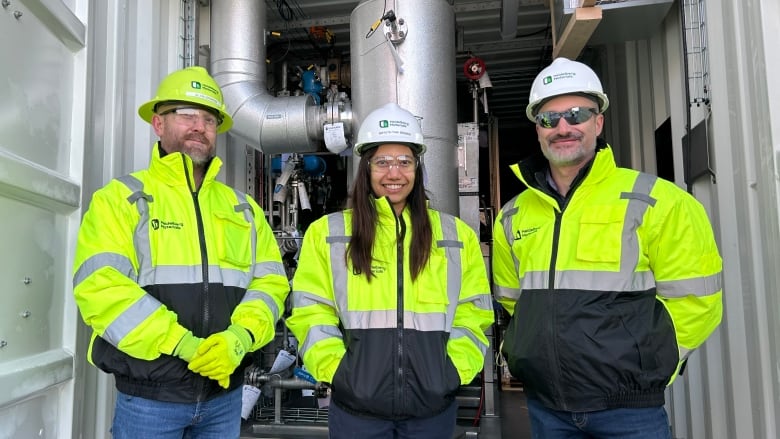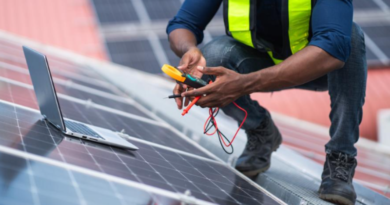Why this company is adopting carbon capture and storage technology in its cement production
Cement is one of the most common industrial materials. It’s used to build homes, schools, and the roads we drive on, but the process of producing it creates an enormous amount of carbon dioxide emissions.
But Heidelberg Materials’ Edmonton cement plant is hoping to produce the world’s first carbon-free cement and will soon launch a carbon capture and storage project to reduce their annual 900,000 metric tons of carbon dioxide by 95 percent.
That’s about the total emissions produced by 200,000 cars a year.
But how does a cement plant produce so much carbon dioxide?
“We produce a lot of CO2 out of our production emissions, and so we need to find a way to control that,” said Brent Korobanik, carbon capture project permitting and community liaison for Heidelberg Materials.
When we take out limestone, our main raw material [that’s] converted to lime, we produce a bunch of CO2, and we don’t have any options to deal with that apart from capturing it.”
According to the Canadian Cement Association, the cement industry accounts for seven percent of global carbon dioxide emissions.
In Canada, the industry accounts for 1.4 percent of all carbon dioxide emissions.
Heidelberg says it is the first company in the world to adopt carbon capture and storage technology to be used in cement production.
How does carbon capture work?
The carbon dioxide emissions produced by the Edmonton Heidelberg plant are emitted when limestone is burned at high temperatures in a kiln, which are usually emitted from a stack into the atmosphere.
What Heidelberg’s carbon capture project will do is redirect the flue gas through a series of stages.
“In a nutshell, what we’re trying to do is capture flue gas from our main cement stack; we need to cool it down,” said Allen Lockwood, project lead for Heidelberg Materials.
“We need to put it through an absorber tower, and we’re basically going to be combining amine with our flue gas that’s going to capture the CO2. Once that CO2 is captured with amine, we need to reheat it.”
After that, the CO2 is compressed and sent to storage about three kilometres underground.
“We’re going to compress it; we’re going to send it into a pipeline that’s under supercritical pressure all the way to the Wabamun hub, where it’s going to be sequestered underground,” said Lockwood.
Testing flue gas from plant
Heidelberg says their carbon capture facility will be up and running in 2026, but in the meantime, they are testing the emissions they produce.
“It’s the first of its kind; we need the data. We need the data to analyze how [our] technologies do against our cement plant,” said Lockwood.
Watuya Srisang, lead process engineer for the project, started at Heidelberg with a lot of experience in carbon capture, having previously worked at the boundary dam in Saskatchewan, which was the first power plant in Canada to use carbon capture technology.
“We have a similar flue gas with a lot of dust and particulate matter in the flue gas, but we think there will be a lot of knowledge transfer from that project to the cement flue gas,” said Srisang.
“One thing that we learned from [Boundary Dam 3] is that the chemistry is very difficult; it’s challenging. That’s why we think okay; the pilot plant will help solve that problem.”
Way of the future
Industry experts say that with the risk of climate change, industries must adapt to make production more green.
“It’s a very particular type of technology that gets at these high-emitting industrial emissions for which there’s not a lot of other options,” said Janetta McKenzie, acting director of the oil and gas program for the Pembina Institute.
“But there’s no silver bullet for reducing emissions in any industry or in any sector across the economy.”
McKenzie says the industry is looking at other ways of producing cement, like using electric kilns, but says it’s difficult to reach the high temperatures needed to break down limestone.
“In the power sector, you have so many alternative options, but… with cement, there’s no other option, and we still want to… build houses and buildings,” said Srisang, who says carbon capture has the most potential to make the industry more sustainable.
Lockwood said he’s excited about what a project like this could mean for the future.
“It’s the future; it’s where everybody’s headed. I have kids; I want to see a brighter, greener future for them,” said Lockwood.
“This presented that opportunity to do a project at scale and help get the industry out there and help build this kind of Alberta homegrown approach locally, as well as what Heidelberg’s trying to achieve globally.”
Source : cbc.ca




